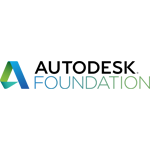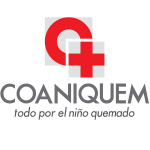SAFE NIÑOS: ENVISIONING CHARITY RETAIL SYSTEMS
- Global Health
- Social Entrepreneurship
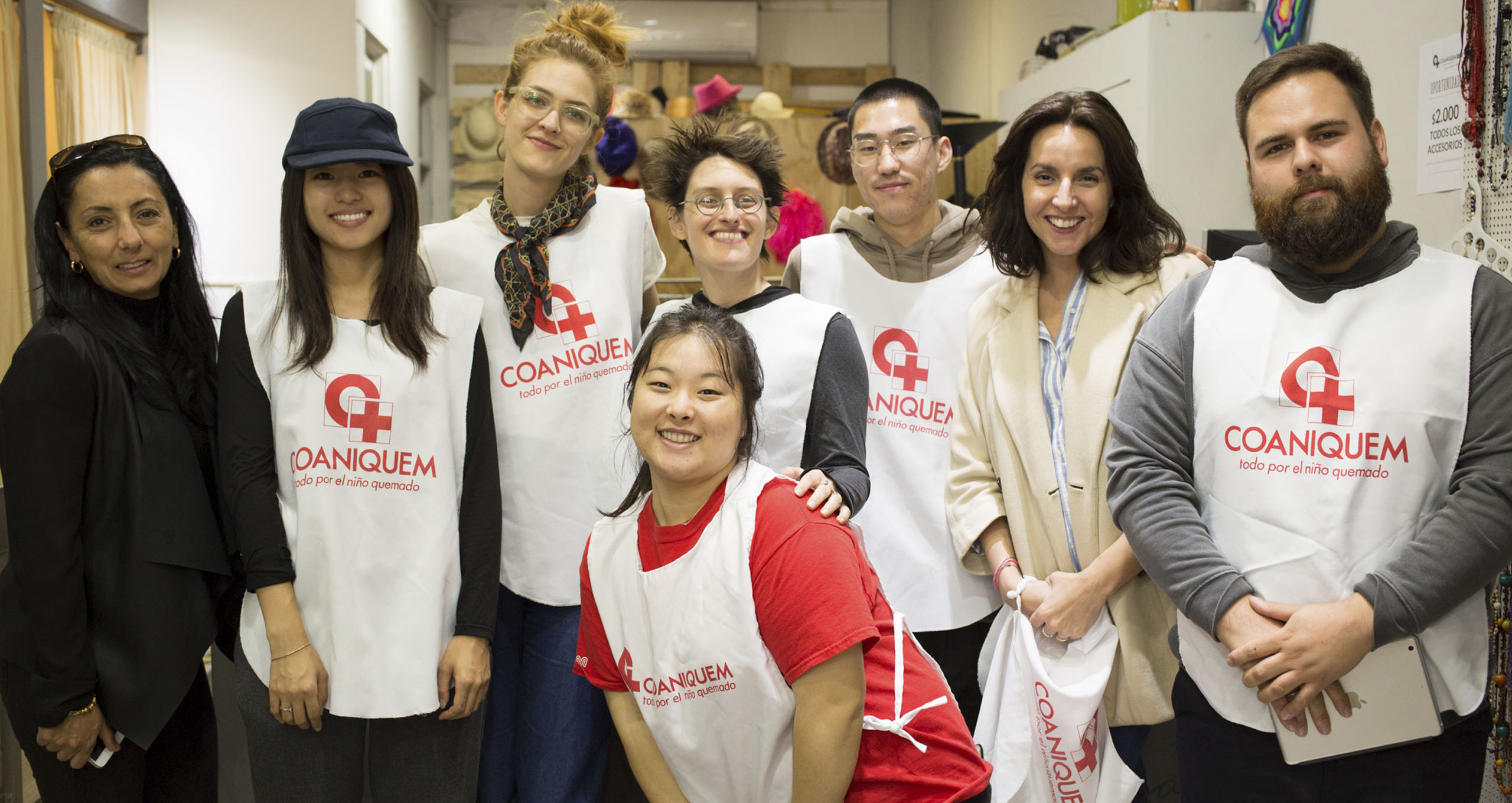
Fall 2017
Inspired by the momentum of the Safe Niños Studio which engaged students to reimagine the 6-acre campus of COANIQUEM – a nonprofit pediatric burn treatment facility in Santiago, Chile and Designmatters partner – this Designmatters Studio challenged interdisciplinary students to design unifying concepts, store layout and back-of-the-store systems for a series of more than 50 country-wide COANIQUEM thrift shops that will raise funds to support COANIQUEM’s free burn treatment programs while building a community of socially-engaged consumers and volunteers.
This project was made possible in part by support from the Designmatters Educational Program Grant from the Autodesk Foundation as well as a grant from the Sillicon Valley Community Foundation.
Project Brief
Fueled by the momentum and the deep connections of the previous Safe Niños Studios, interdisciplinary ArtCenter students were challenged to design a system of charity thrift shops throughout Chile that will raise funds to support COANIQUEM’s free pediatric burn treatment programs in addition to creating a community of socially-engaged consumers and volunteers as part of the larger COANIQUEM family of care and compassion.
As nonprofit charity shops are a new phenomenon in Chile, students considered how best to introduce the concept and develop high-impact, resourceful innovations for real-world implementation of the 50+ stores planned to open in 2018. Co-creating with COANIQUEM stakeholders, students needed to develop design solutions that would incorporate three key areas: the physical retail experience; branding and visual communication elements; and strategic resource systems for day-to-day store operations.
Students traveled to Chile for in-depth, two-week field research at the current operational COANIQUEM thrift stores; upon their return, they formed teams to tackle specific design challenges to create innovative, cost-effective and easily scalable options.
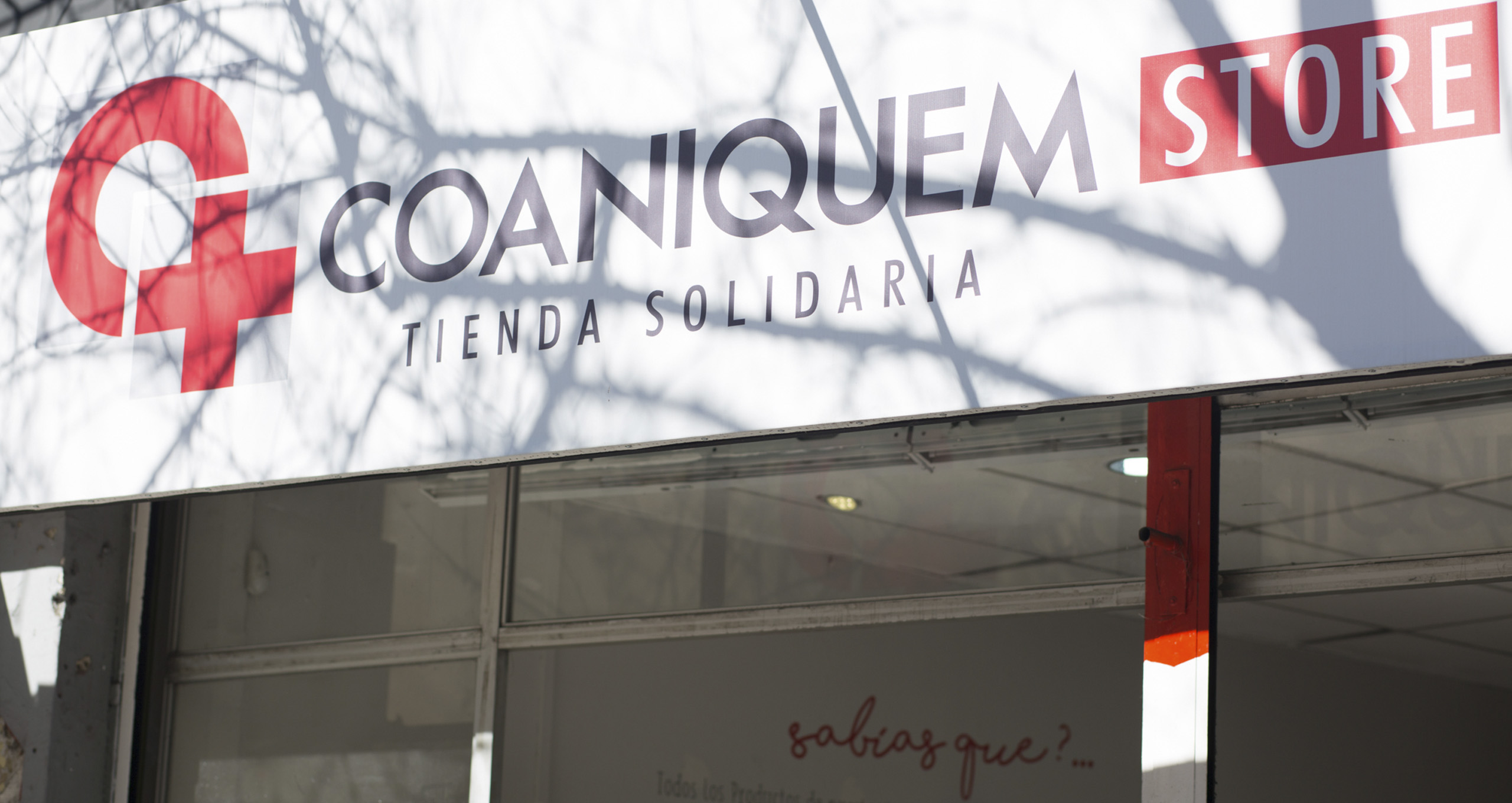
“In most classes, by midterm you have a design lock so all you need to do is produce that final model. In this studio at midterm, we were able to come up with 40 pages of new concepts as well as refinements for the old ones. We realized there is so much that needs to be done – and we only have so much time and we want to do as much as we possibly can. That thinking comes from a place of humility. The design is never perfect; what we presented at the final is only step two of 100; everything here will continue to evolve as we learn from the prototypes and implementations.”
– Matthew Simon, Student, Product Design
About Burn Victims and Latin America
Across Latin America, more than seven million children are involved in burn accidents every year, the result of being too close to hot liquids, open fires, electrical fires, fireworks and other household appliances. About 90 percent of burn accidents involving children happen at home, even when parents are nearby.
In Chile alone, 100,000 burn accidents occur annually with the majority of accidents involving very young children (ages 5 years or younger).
For burn survivors and their families, a burn accident marks the beginning of a lengthy and painful process of treatment and rehabilitation that will address not just the physical scars, but psychological and emotional ones as well.
About COANIQUEM
Located in a residential area in Santiago, Chile, COANIQUEM has provided compassionate treatment for more than 100,000 children suffering from burn injuries since its inception in 1979 by Dr. Jorge Rojas-Zeger. Many children and their families live in underserved communities across Latin America but receive the extensive treatments free of charge thanks to COANIQUEM partners and international support.
On average, COANIQUEM cares for 8,000 patients annually, welcoming young burn survivors and their families to live at the six-acre campus for weeks and even months during intensive treatments and therapy sessions. Often burn survivors must return for regular follow-up rehabilitation treatments, a process that can take decades depending on the severity of the original injury.
COANIQUEM offers a holistic care approach that treats body, mind and spirit. In addition to a highly proficient medical and therapeutic staff, COANIQUEM incorporates other trained professionals to journey with the patients and their families through the healing process.
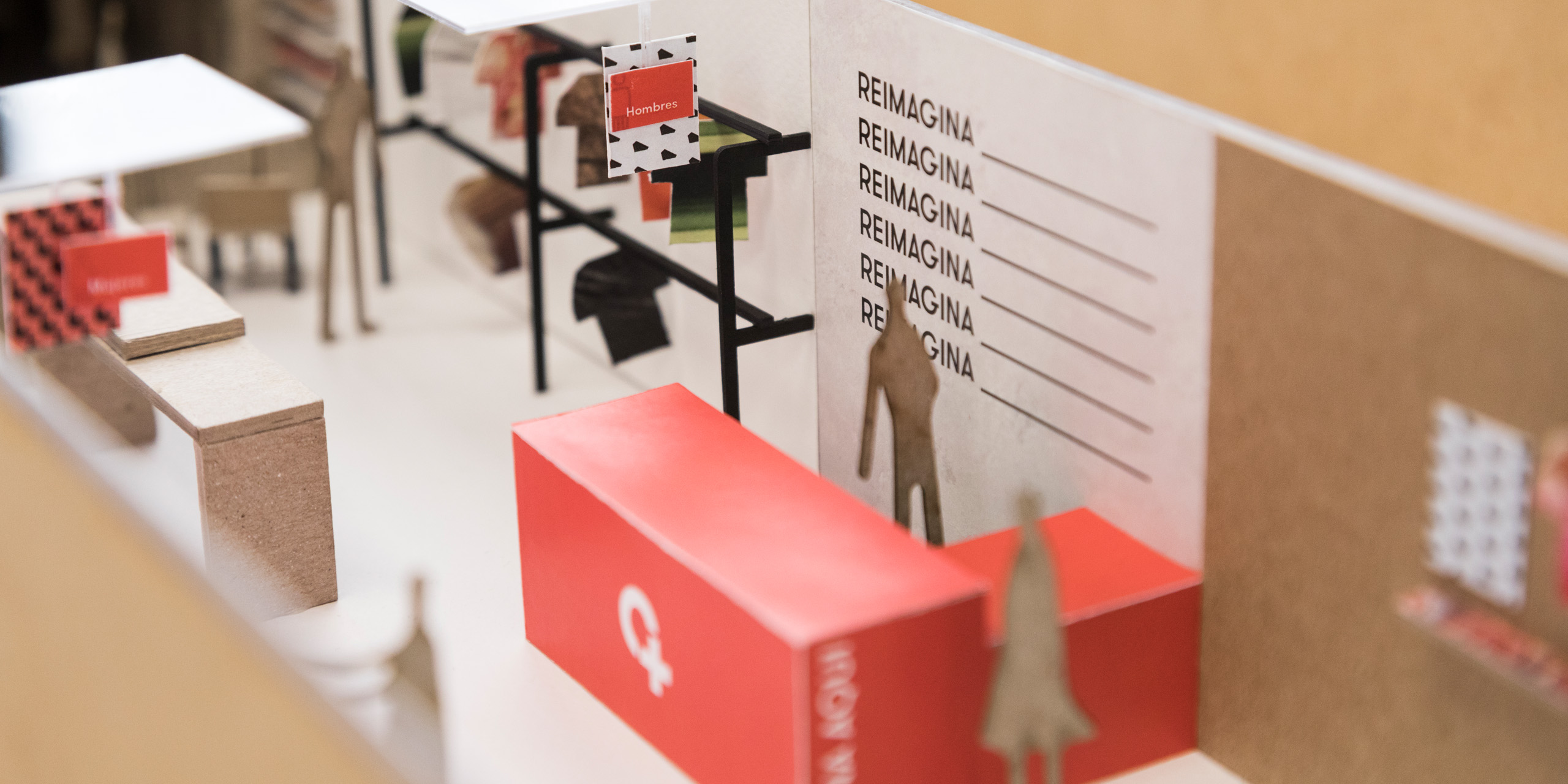
“The two-week experience on the ground in Chile was instrumental. We all felt the same thing; we all saw and experienced the same realities together. We all lived the same moments. And that really helped us later as a design team, as we related our ideas and concepts back to our shared experience.”
– Andres Zavala, Student, Environmental Design
Research and Project Development
Students began their Safe Niños design journey with a two-week immersive stay in Santiago at the COANIQUEM campus as a way to deeply connect with the COANIQUEM experience. They stayed at the Casabierta, COANIQUEM’s on-campus residence, and interacted with the staff and families, learning their stories and playing with the children.
Students toured and volunteered at COANIQUEM’s three inaugural thrift stores in the greater Santiago area, discovering the unique neighborhoods and clientele. They folded donations, stocked shelves, interacted with customers and engaged with volunteers in a deeply empathic experience. They observed, shadowed and asked questions to understand what motivates volunteers, how employees interact with the community and how donations are managed. This field research provided moments of insights and invaluable connections to COANIQUEM stakeholders: the donors, customers, volunteers and patients/families.
Throughout their two-week stay, students addressed various prompts as catalysts for their design thinking. They investigated how other charities and social enterprises successfully raise funds through innovative media campaigns and in-store graphics/branding. Delving into current retail themes and trends, students discovered how retailers create memorable shopping experiences for their customers to increase loyalty. As they examined the retail environment, students uncovered how displayed merchandise can enhance a brand’s identity.
Seeking to tap into the success of the COANIQUEM as a brand, students gathered examples of powerful graphics and language used in effective COANIQUEM campaigns as well as other Chilean social issues. Students examined how the public perceives COANIQUEM and what specifically makes it beloved by so many Chileans and South Americans.
To understand the psychology of thrifting, students developed personas, using archetypes as a jumping off point to examine aspirations, motivations and Chilean lifestyle characteristics. Based on real interactions with customers, students created a user’s journey map, diagraming the stages a user goes through in the shopping experience.
Students explored upcycling as a fast-moving trend in Chile thanks to innovators, mobile technology and environmentally conscious citizenship.
Since the COANIQUEM stores would rely on successful donations, students looked at how other charity stores effectively work with donors through messaging and systems; customers need to know their purchases will have a positive impact for families in need. Additionally, students learned how online retail is changing the landscape for buyers and sellers.
Because volunteers are at the heart of many charity stores, students examined how other charities keep their volunteers happy, engaged and active ambassadors for the brand.
Students participated in onsite workshops, sharing challenges and observations, defining areas of opportunities, and brainstorming “What Ifs.”
For their second week in Chile, student teams went deeper into their initial ideation, working closely with COANIQUEM’s Jorge Goldsack, Gerente Fundación and Maca Mujica, Director Tienda Solidaria, to ideate short and long-term challenges and prioritizing design needs given the quick turn-around schedule.
Students documented the current COANIQUEM retail experience by creating a current store plan layout; they noted typical traffic flow, where products were placed, how storage was utilized and how branding signage was implemented.
Students began conceptualizing how to brand the spatial experience with a unifying theme which could be implemented on all current and future store expansion, regardless of neighborhood economics and location. Students also considered how to incorporate the easily recognizable COANIQUEM logo which is familiar to Chileans everywhere.
COANIQUEM staff strongly encouraged student’s conceptual designs include a community space in each store that would be used for workshops, gatherings, family activities, storytelling and other cultural events. The community space could be a stand-alone location or could be easily created from movable store elements.
Teams crafted temporary branding and messaging prototypes – banners and posters – on site to gauge reaction from store customers and volunteers.
Students closely examined the current donation procedure of collecting, storing and distributing goods and began thinking how to streamline that system to be efficient and cost-effective as well as straightaway scalable given the rapid schedule of new stores opening. They created diagrams of the donation process, highlighting pain points and design possibilities. Additionally, they investigated Chilean recycling laws and ways to partner with local government and community organizations to help limit donated goods from going to waste.
Students also examined the current local trends in Chilean fashion, shopping and other retail directions through neighborhood visits, creating mood boards with thematic imagery and brainstorming sessions that fueled ideation on possible new retail locations, pop-ups, mobile stores and school events.
Returning to California
Upon returning to the States, student teams moved from inspiration to ideation to prototyping.
Working with a collective vision, student teams needed to address long-term strategies, available resources, the pressing time factor, and how to incorporate specific local identity into each store design while retaining the connective elements of the larger COANIQUEM brand.
Two teams worked on branding/identity social-impact design concepts while another concentrated efforts on creating a streamlined back-of-the-store system for receiving, sorting and storing donations. After midterms, one branding team took on more specific challenges involving transformable fixtures/furniture for the stores and trade show set-ups.
Students employed emotional storytelling, re-imagined the store’s floor plan and conceived branded visual graphics that would be functional and convey the mission of COANIQUEM. Additionally, they targeted potential volunteer types and investigated best strategies to effectively reach and involve those specific groups.
Students continued to investigate trends in socially responsibly charity thrift stores and read numerous case studies from organizations that had found a successful marketplace niche. Students learned the history of Goodwill’s specialized “Rare by Goodwill” boutique in Orange County, and toured and examined the systems of enterprising thrift organizations like The Salvation Army, Out of the Closet, Saint Vincent de Paul and more.
Students maintained close touch with the COANIQUEM staff during the process as they refined and retooled ideas; midterm prototype presentations to COANIQUEM and ArtCenter faculty provided teams with tangible feedback and solid ideas on how to further push their designs and concepts closer to innovative, workable and cost-effective solutions.
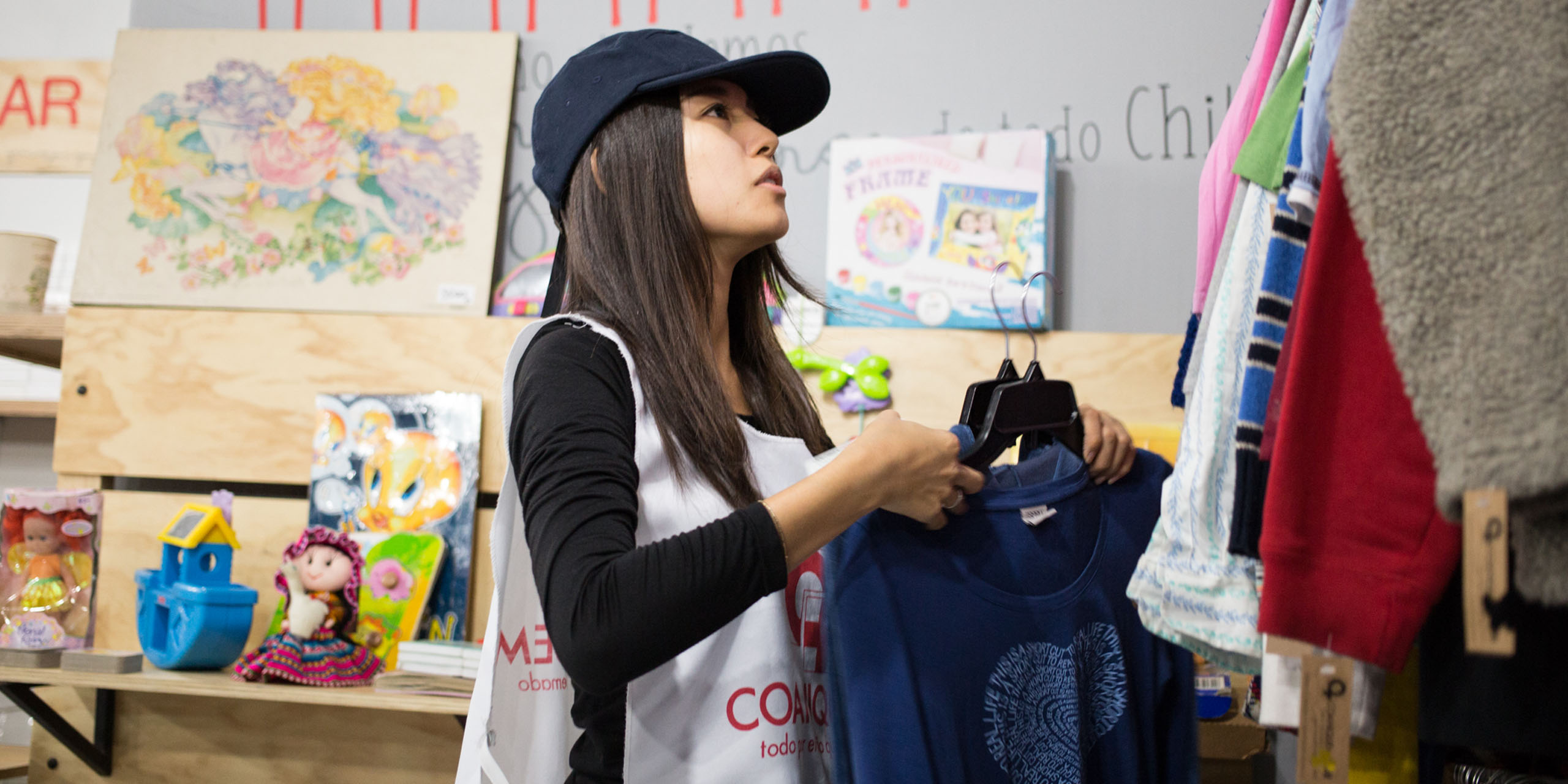
“Since the very beginning of this project, these students showed a strong commitment. They were really receptive and had an open heart when they came to COANIQUEM hearing the stories we told them and the things we showed them. They really focused on the practical needs of COANIQUEM.”
– Jorge Rojas Goldsack, COANIQUEM Gerente
Outcomes Overview
Since the students’ initial stay in Chile, COANIQUEM expanded their thrift store reach from three to eight locations. Students incorporated two of the new locations (one serving in an affluent neighborhood and the other a working class community) into their final design presentations, demonstrating how each store could have localized elements while still featuring unifying branding concepts.
Teams compiled their detailed concepts and implementation into playbooks and toolkits that would easily guide COANIQUEM staff into incorporating the design ideations into the already operational stores as well as stores in the planning stages.
Project Outcomes
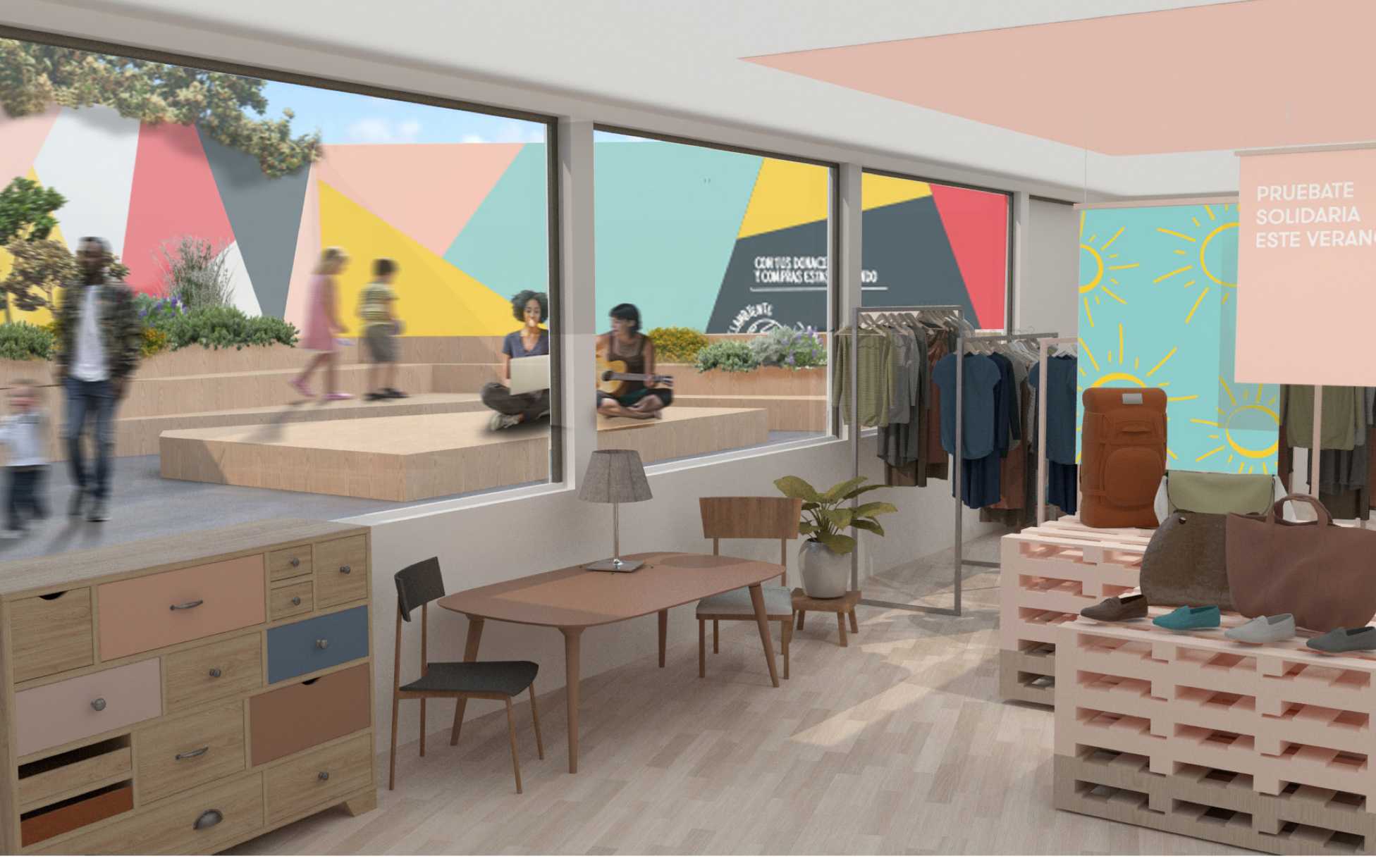 close
close
Graphic/Branding Strategy Team
Read moreConner Kim, Michelle Kim, Chikako Sakamoto, Brett Su
This team conceptualized their design thinking at the Las Condes store, located in an upscale neighborhood of Santiago.
To connect the stores in the spirit of COANIQUEM and to touch the hearts of customers, the overall spatial messaging often incorporates the dreams of children who are the central COANIQUEM patients. Using the aspirational innocence of childhood is focused to create an instantly recognizable benefit for shoppers, donors and volunteers.
Overall, the team separated three distinct level of messaging: large (found on walls, ceilings and windows), medium (illustrative posters, directional signage) and small (fitting room text, sales tags, receipts, etc.). When appropriate, as in the case of the text on the fitting room mirrors (“Solidarity looks good on you!”), signage can be playful and witty.
Bold outdoor graphics in the red COANIQUEM color announce the store as an extension of the COANIQUEM campus. A nearby chalk wall on the pedestrian level presents seasonal messaging.
Inside the store, wall graphics remind shoppers of the impact of their purchases. Additionally, numbers are displayed to quantify the impact of a customer’s financial buy. Notices could also display assistance collected from this particular store; assistance that goes to help children in need.
Mixed media messaging posters present kids’ personal dreams of the future as superheroes and other positive role-models. Using photograph of actual child patients, the posters utilize color-saturated Illustrative detailed background of the cityscape reflecting Chilean skylines.
The teams devised a color zoning system that would make directional wayfinding easier for customers and volunteers. The Pink Zone at the entrance explains the mission of the store; Red Zone designates where merchandise can be donated; and the Multicolored Zone points to community spaces. Seasonal items would be coded in the Blue Zone. Additionally, coupled with iconographic line drawings, merchandise is color noted for men, women, children and home goods.
A wall display that features Staff’s Favorite Picks of the Week includes handwritten messages from staff and volunteers.
Colorful patterns and seating in the Reading Room provide families with children a destination to interact. Books and small toys are nearby as is information about burn prevention.
A central island section can showcase seasonal items and clothing; large nearby windows open up to a re-imagined outdoor patio area. This inviting location has a chalk wall for children, space for murals, low comfortable seating for adults and a ‘stage’ area. Simple string lights accent the patio along with greenery. The patio can be utilized as a community hub, offering music and dance performances, family activities and store-related events.
Cash/Wrap signage incorporates one last push to the shopper, reminding them that here is where donations are accepted, people can sign up to volunteer and that every purchase helps keep the dreams alive of the children in COANIQUEM’s care.
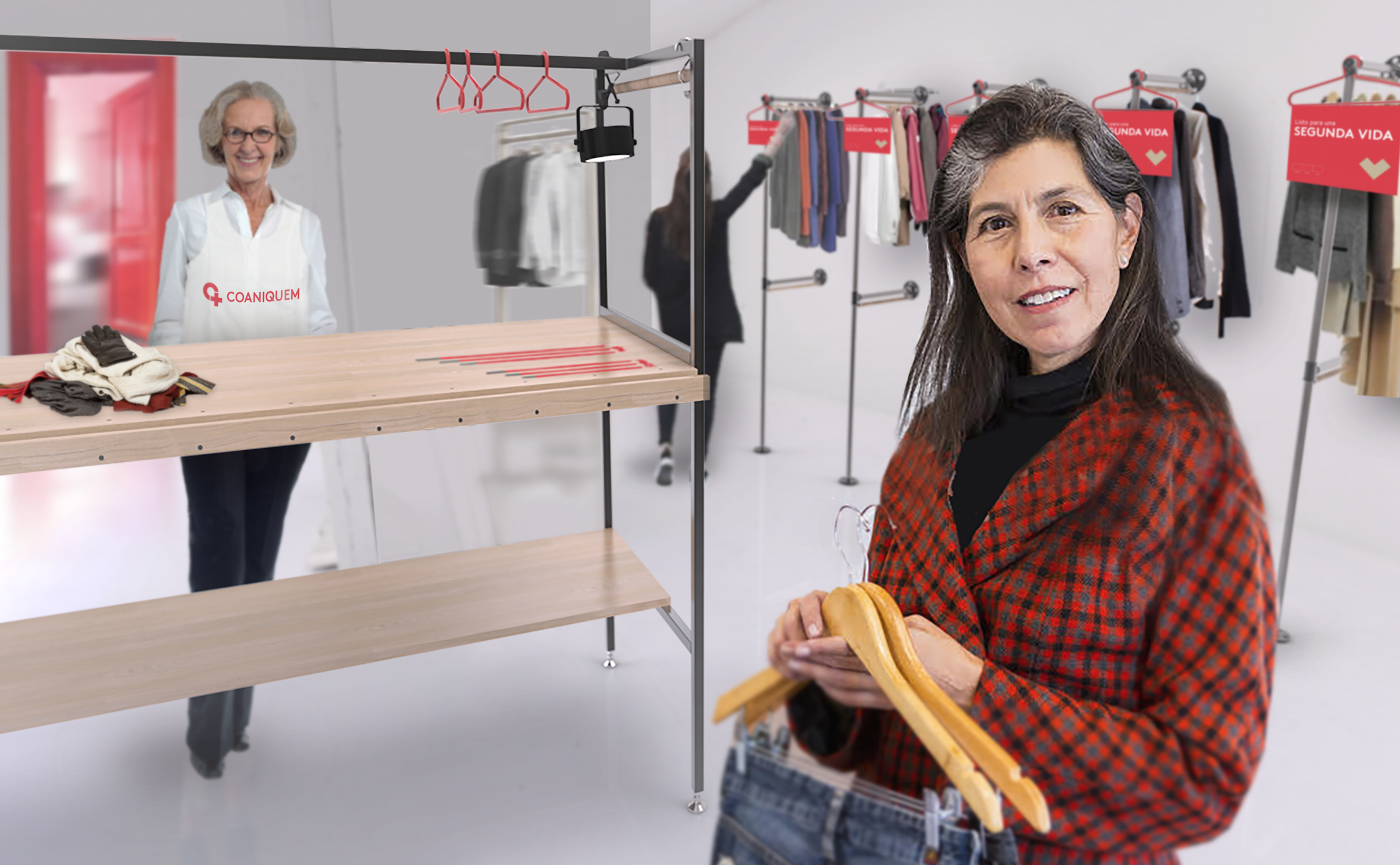 close
close
Systems Team
Read moreMiranda Lapour, Yixuan Liu, Matthew Simon
Students ideated on functional operational aspects for a people-centric (volunteers, customers, etc.) design that contributed to a culture of gratitude and support, a red string strategy incorporating multiple functions throughout the store.
The team outlined a method for handling and sorting donations, targeting the three types of people who touch donated merchandise: donors, volunteers and customers. The first sorting happens at the Cash/Wrap where donors fill out a slip that describes the merchandise they are donating. These donations are then easily separated into gray bags for soft goods (clothing) and red bags for hard goods (home items, shoes, electronics).
A reconfigured and scalable Sorting Room Table presents a communal-style designed workplace where volunteers can interact with one another as they work.
Made out of wood and steel, the table itself helps organize clothing; a sizing chart on the table top helps sorting, tile racks are conveniently located within arms’ reach, and a modular-designed bar with handle makes it easy to move multiple pieces of clothing especially up and down stairs.
Knowing that the layout of stores will vary, the team created a tool box of potential floor plans, small tables and shelving that can be used to design future stores.
A comfy home-like space will be created in each store for volunteers to rest, relax, enjoy a snack and engage in conversation. Nearby, a cork board will feature volunteer photos that can be designate weekly schedules. Photo cards can be stamped with hours to track volunteer time.
To deepen the connection between the work volunteers do and the children of COANIQUEM, counting data display will be displayed describing the direct impact of a rack of clothes, translated into monetary help. Volunteers can update the counters weekly and/or target the display for store-specific impact.
A membership or Thank You card, stamped for every purchase or volunteer hour, can be redeemed for store discounts. Volunteers, customers and donors who wear a collection of simple-styled pins (e.g. the heart pin, etc.) can show their solidarity to the children of COANIQUEM.
External marketing efforts will address both macro and micro messaging. Brand ambassadors, regional celebrities and notable faces will engage the cause by using the hashtag #paralosninos. Social media (Instagram, Facebook and Snapchat) will include photos of items, volunteers and the store experience. Outreach will be directed to young Chileans on platforms familiar to college students, inviting them to becoming volunteers.
In the store itself, an Instagram Wall can display rotating images.
Social media will also share stories of the journey of children of COANIQUEM, volunteers having fun, announcing upcycle workshops and local media strategy of community events. Social campaigns can include appealing to local families and seasonal happenings.
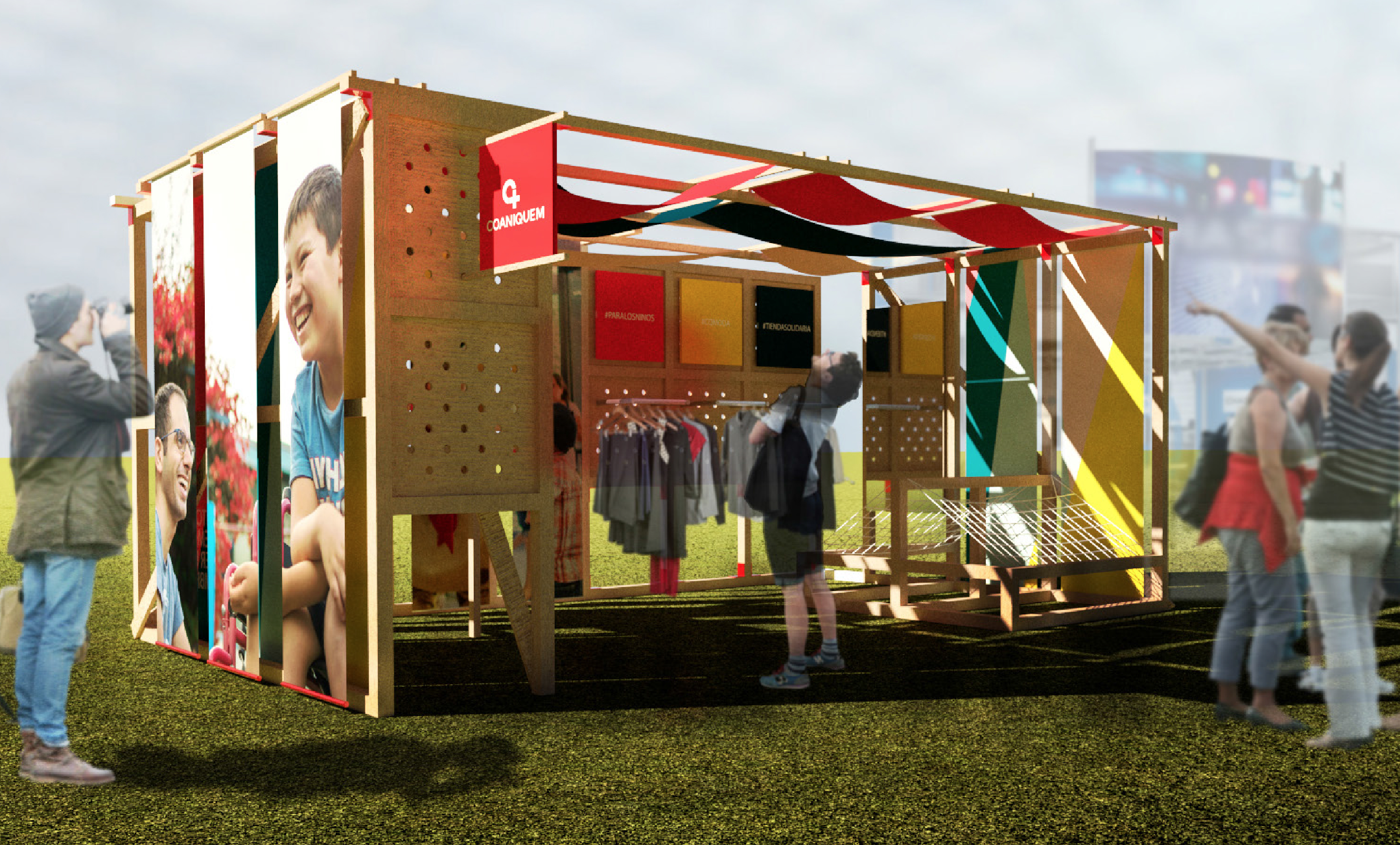 close
close
Fixtures and Transformable Furnishings
Read moreIlyena Kim, Maricruz Meza, Erh-Te Tsai, Andres Zavala
Using the floorplan of the current COANIQUEM thrift store in Maipu, a working-class neighborhood, the team delved into the details of how store fixtures and furnishings could illuminate the mission of the store, provide a pop-up space for store and local vendor merchandise, and how furnishings could be designed for multiple uses.
Environmental graphics can include outside window visuals that incorporate store hours with mission messages. Inside, text on stairway steps can remind customers that their purchases equate with helping a child at COANIQUEM.
Located near the entrance, a pop-up shop can highlight a local artist/vendor/entrepreneur or store merchandise. Items are displayed on an adaptable plywood peg board design that uses long metal pegs that can be configured in a myriad of ways to hold display items. The pegboard design can incorporate a ceiling side to hang merchandise down into the area. The pegboard can be any size to fit into any store size.
To reduce clutter in the Cash/Wrap near the cash register, the counter surface will have a lowered level for bags. Wall messaging will provide pertinent store information – including donations accepted – along with reiterating the mission of the thrift store as COANIQUEM.
Transformative furniture will change a store display area into furniture that can be used for community and after-hours events. With a few quick moves, a retail surface can be turned into a community table, a mirror on the wall can become a tabletop, and a table transforms into a couch.
Old unsellable clothes – like jeans – can be created into functional furnishings like poufs which can also demonstrate the value of upcycling.
A trade show booth that describes the work of COANIQUEM and encourages volunteers can be employed at festivals and community events to attract young people. Social media hashtags can help market where the booth will next be seen. Incorporating bold colors, banners and Instagram photos, the booth features the peg board walls (with items for sale), hanging graphics along with a seating system. The booth will be easy to frame and be created out of plywood and lightweight joinery.
Video Content
Project Publicity
Next Steps
Continuing the process of this studio, Designmatters will offer a Safe Niños Development Seminar in Spring 2018 which invites students familiar with the Safe Niños project to further refine thrift store concepts that can be immediately implemented in the current COANIQUEM stores as well as designed for the future stores.
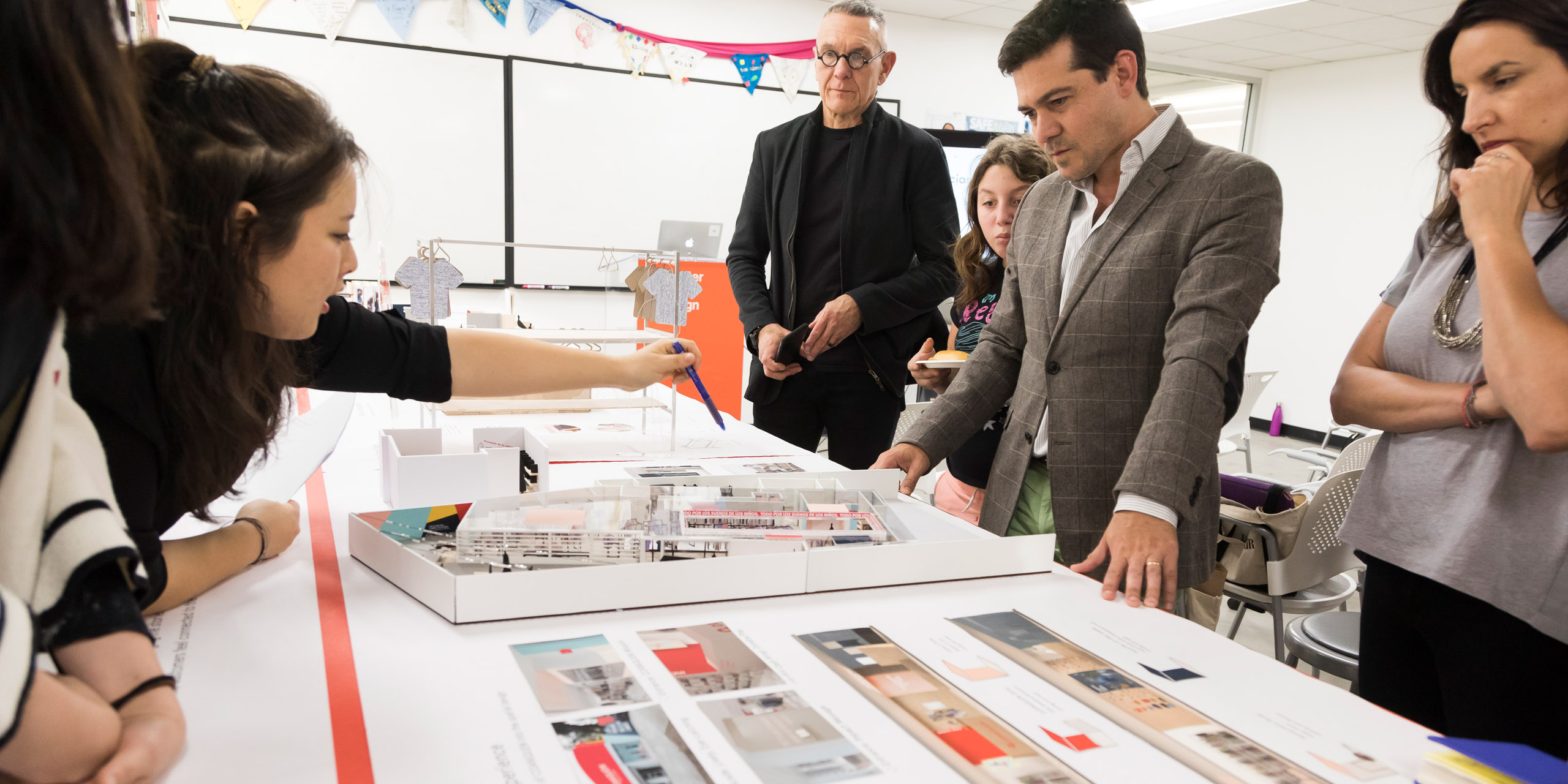
“The ‘why’ behind this project is so strong; helping kids who have suffered horribly as well as supporting their families. That ‘why’ really spoke to me. Why we had to help, why we had to design and what’s really at stake. I am so exhausted at the end of this studio; I’ve never had such an intense workload with such an incredibly invaluable experience.”
– Michelle Kim, Student, Illustration

